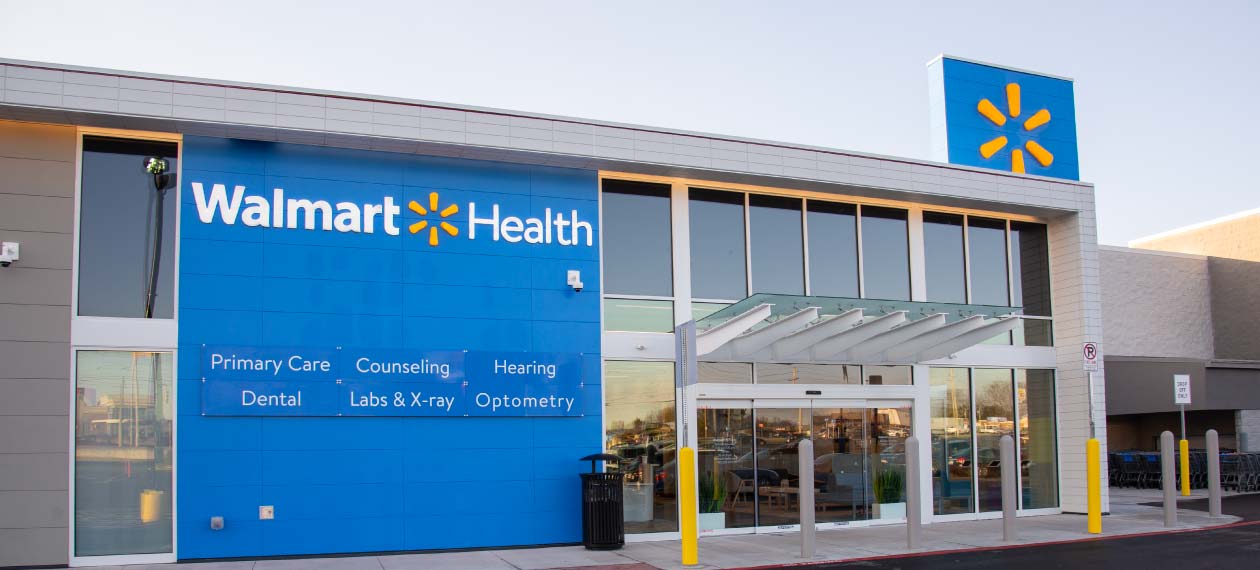A visit to the doctor impacts consumers’ time, budgets, and sense of well-being.
Walmart put those three elements at the forefront as it created Walmart Health, its answer to issues surrounding access and the affordability of healthcare in communities across the country.
While there are just six locations currently open, LB Johnson, Vice President, Health & Wellness Real Estate Development for Walmart, envisions a more robust presence in communities in need of health services.
Johnson, who has been with Walmart for 15 years, shared the concept and vision of Walmart Health during a discussion at RetailSpaces (Almost) Live.
"We're able to provide access and affordability that does not exist throughout the country, and help solve a healthcare challenge that is pretty monumental," he said.
Here are six things we learned about Walmart Health during RetailSpaces [Almost] Live.
Meeting A Need
Citing statistics that one in four families worry about the cost of healthcare, and one in three choose not to seek care because of costs, Johnson said that Walmart has set out to remove those barriers through Walmart Health.
The concept aims to deliver a customer-driven care experience that values time, money, and well-being by bringing primary care, dental, optometry, and other services together in one location.
With standalone locations, Walmart Health has already begun to serve a need in communities where healthcare services either aren't readily available or aren't affordable for residents, Johnson said.
"We are seeing a large share of clients and patients come in as cash-payers without insurance," he said. "We're able to provide affordable services to them starting with primary care, but integrating with dental, optometry, and behavioral health."
Finding A Building Fit
The first Walmart Health location was built in Dallas, GA and covered nearly 11,000 square feet of space. Johnson admitted it was “a little monolithic.”
The original design was based on research that looked at the four dimensions of the consumer: the patient, the wellness consumer, the shopper, and the medical professional.
"We spent a lot of time with surveys and interviews and focusing on each dimension of the consumer to see what that customer segment would like to see in a facility," he said.
That data led the team to build and tear down several Walmart Health design mockups in a warehouse near the company's headquarters in Bentonville, AR.
Embracing Modular
After a few design attempts that didn’t quite achieve their vision, Walmart Health began a partnership with BLOX, an Alabama-based company that specializes in medical modules.
"While we felt we had a really good understanding of those dimensions of the customer and who we were trying to serve, there is also flow and efficiency you have to bring to that box," Johnson said.
The partnership, he went on to explain, allows Walmart Health to more efficiently and effectively deliver the new service to customers. This new team began to reexamine the volume and usage of space.
"We see 50,000 to 60,000 customers a week in any given Walmart SuperCenter, so there will be volume in these units," Johnson said. "We brought in BLOX and restructured and reiterated the design, and got it down to 6,000-6,500 square feet."
Becoming Efficient In Design and Resources
Because Walmart Health locations are being built alongside existing Walmart SuperCenters, Johnson said they were able to simplify the building processes.
"A big part of the challenge in the commercial industry is we didn't recover on the supply and demand in skilled labor," Johnson said. "When you look at traditional construction, as you look to scale a program, there is a risk of increases in costs as you increase the demand.”
By partnering with BLOX, Walmart Health has been able to utilize modular building to cut down on costs, without sacrificing speed or quality.
"Typically, you give up one or two and trade-off for the other," Johnson said of speed, cost, and quality of a building. "With this approach, we can deliver on all three."
In fact, Johnson said through the manufacturing approach used by BLOX, Walmart Health anticipates finding cost efficiencies as they grow.
![]()
The first build Walmart Health and BLOX undertook together came in the form of eight modular pieces that were constructed to form a base within 48 hours.
In all, that first build took just about 90 days for completion, with subsequent builds happening within 45 days. The goal is 30 days or less, Johnson said.
The speed of building Walmart Health locations is a result of the manufacturing processes used by BLOX and the existing infrastructure provided by the Walmart SuperCenters already on location.
“Not only are the subgrades, utilities, and fastenings already installed, but we’re also tapping into the existing infrastructure — the electric, plumbing, and data cable from the SuperCenter itself. That’s another aspect of how we are able to deliver speed and certainty for the health centers.”
Additionally, the project has focused on sustainability and what Walmart CEO Doug McMillion has dubbed "regeneration," going beyond sustainability to also give back.
Through its manufacturing process, Walmart brings in all supplies in the raw form and then uses computers to laser-cut materials to fit designs, resulting in zero waste, Johnson said.
"The BLOX facility sits in an old rail car plant," Johnson said. "The community was thriving prior to manufacturing and steel getting shipped overseas. That community has been decimated. As we look to scale and build upon that, we regenerate that community."
Focus on Customers
As Walmart Health has become more efficient in building, it has also reimagined what the inside of a health center should look like.
When it came to the flow of Walmart Health locations, Johnson said the team has refocused on efficiency for clients and patients seeking primary, dental, optometry, and behavioral health services.
"The synergies and cross-pollination of services will increase the health and wellness of individual patients," Johnson said.
One goal they had early on was to integrate and centralize medical staff. When first designed, Walmart Health featured a centralized area where medical professionals huddled. Once BLOX joined the team, they determined they could increase operational through-put by putting medical professionals where they deliver services: just outside patients’ doors.
Though the onset of the COVID-19 pandemic hasn't impacted the building or rollout of new Walmart Health locations, the team has made changes throughout the evolving situation.
For instance, Johnson said that as the pandemic began, his team identified an opportunity to maintain the safety and welfare of pharmacy operations with the use of sneeze guards.
"We went out over the weekend to develop the sneeze guard that we were able to fasten and rollout to Walmart and Sam's Club," Johnson said. "We rolled it out in two weeks. It was a phenomenal feat."
The team is also working to increase convenience and safety for customers through technology and contactless environments.
"Through the use of technology and scheduling apps, customers are able to notify the pharmacy when they will be arriving and pharmacy staff will hand-carry prescriptions out the door to the customers so they don’t have to come in,” he said.
Looking to the Future
Johnson and his team, while they continue to explore ways to ensure Walmart Health works efficiently, have what he calls a “product mindset.”
"The end in mind is relative to the customer," he said. “My team leads with a product mindset, designing to truly understand and empathize with the customer. We'll keep marching forward, keeping customers at the forefront of every design as we reimagine space in retail."
Marching forward is just what Walmart Health is doing. Johnson said that his team plans to continue rolling out new Walmart Health centers in Florida, Arkansas, and Georgia.
"By the end of next year, we'll have a few dozen," he said. "At the height of our SuperCenter expansion there were 300 to 350 stores a year; our goal is to triple that rate of delivery once we get to scale."
Johnson and his team are prepared to do just that and face down any challenges that may occur along the way.
"By far, the health-centered concept and growing it is going to be one of the more complex initiatives that I’ve had the challenge and opportunity to lead,” he said.

Posted by
Physical Retail Reimagined.
RetailSpaces is a community for store development and design innovators.
March 29-31, 2026 | San Antonio, TX
Learn More!








Comments